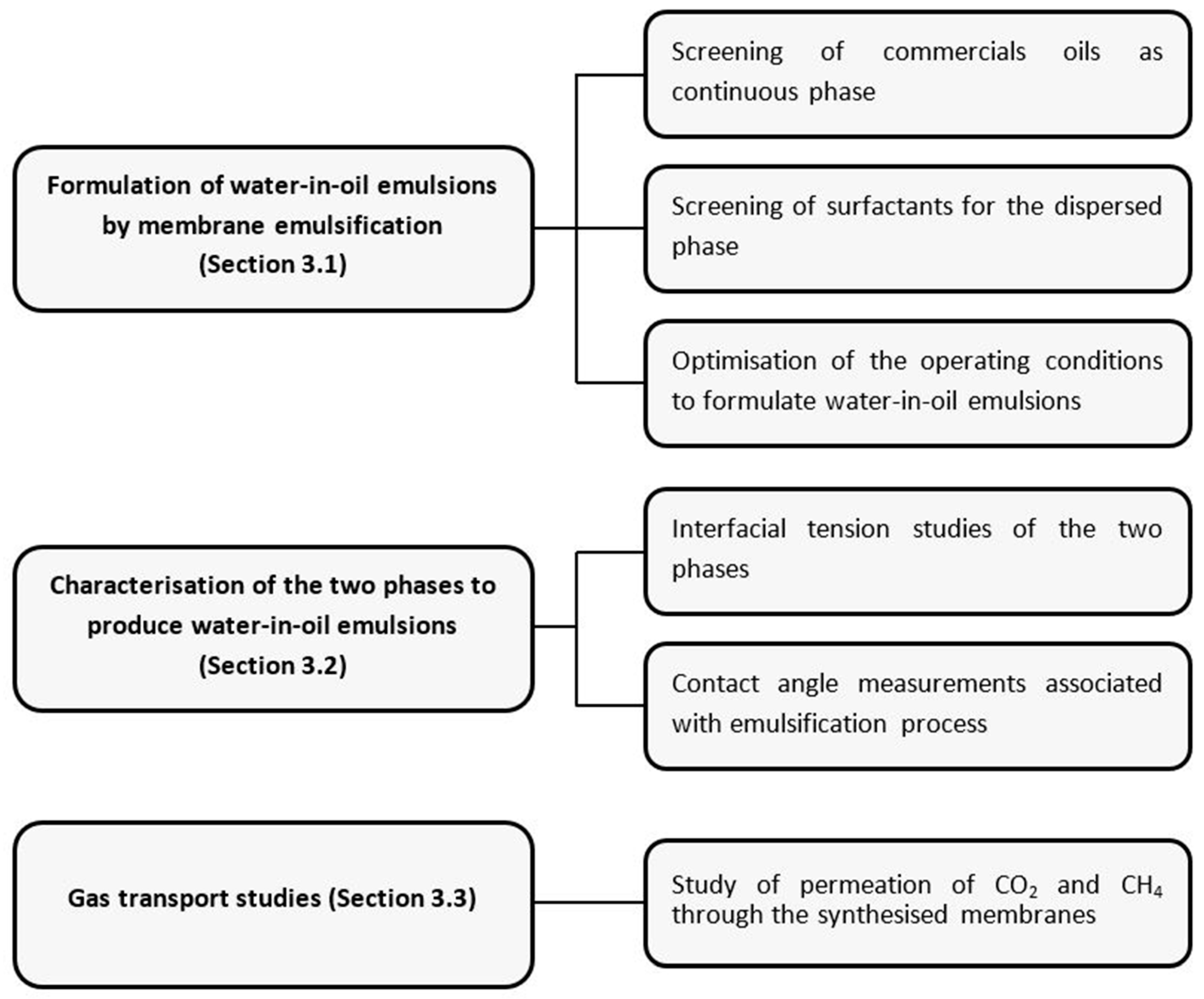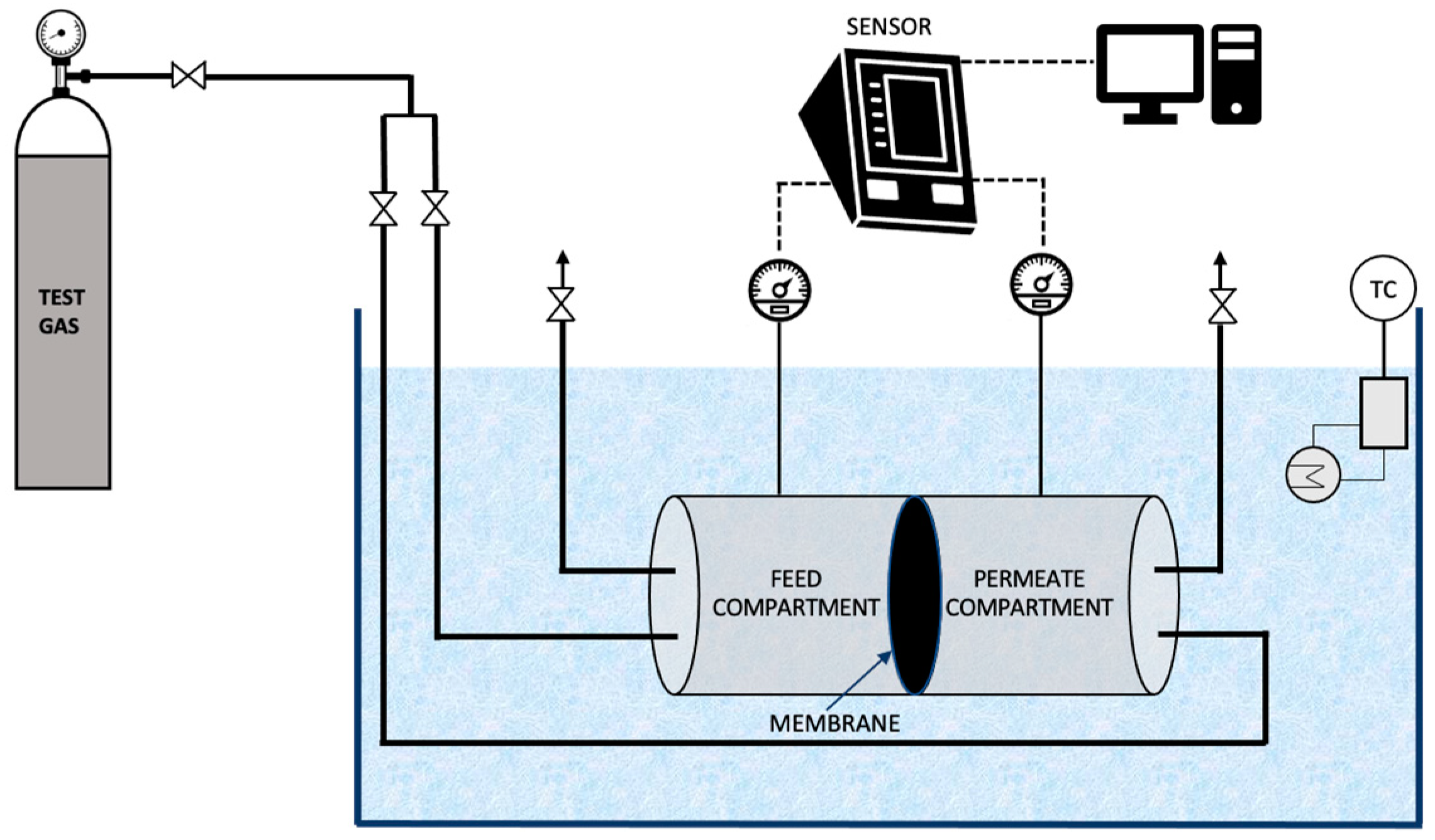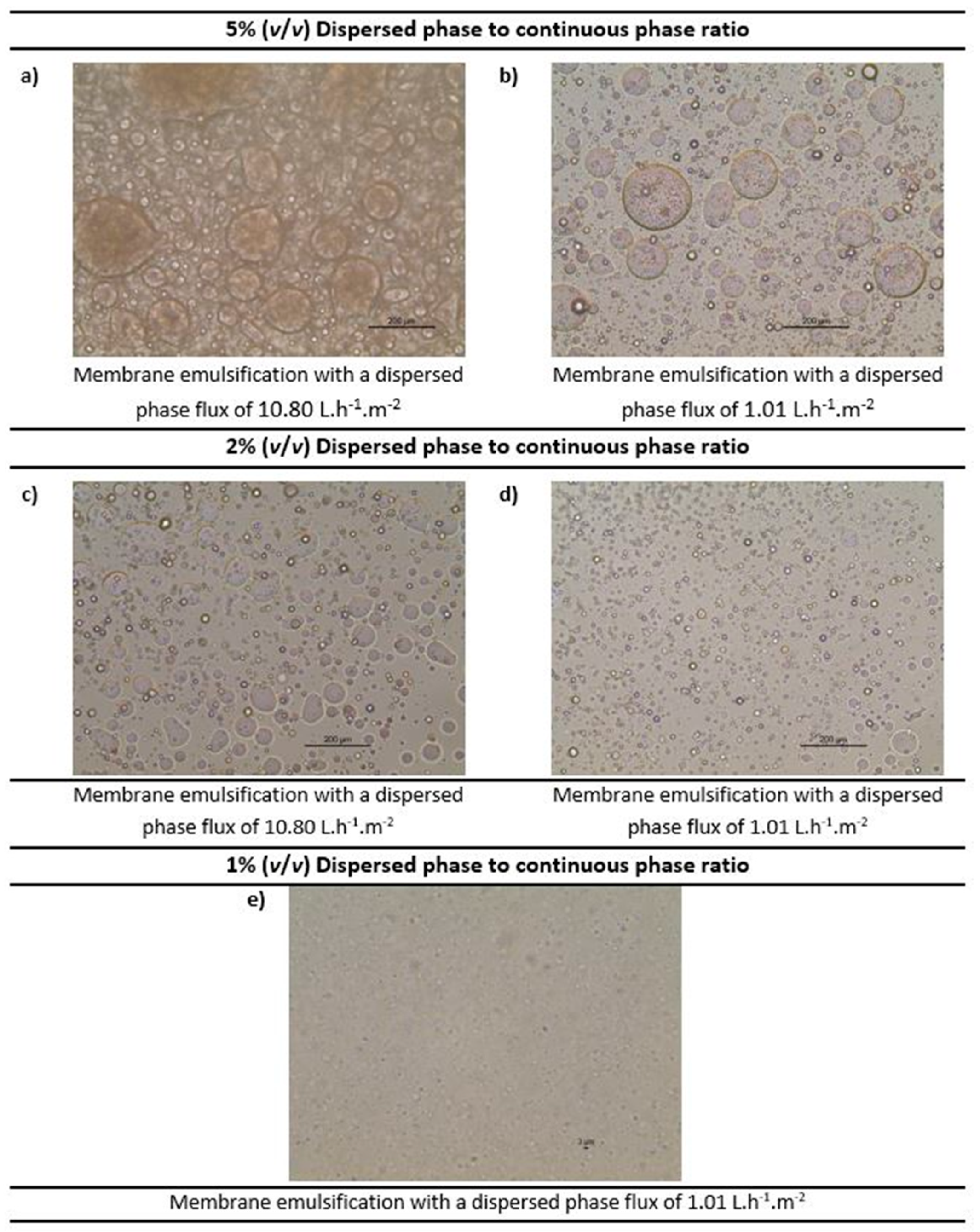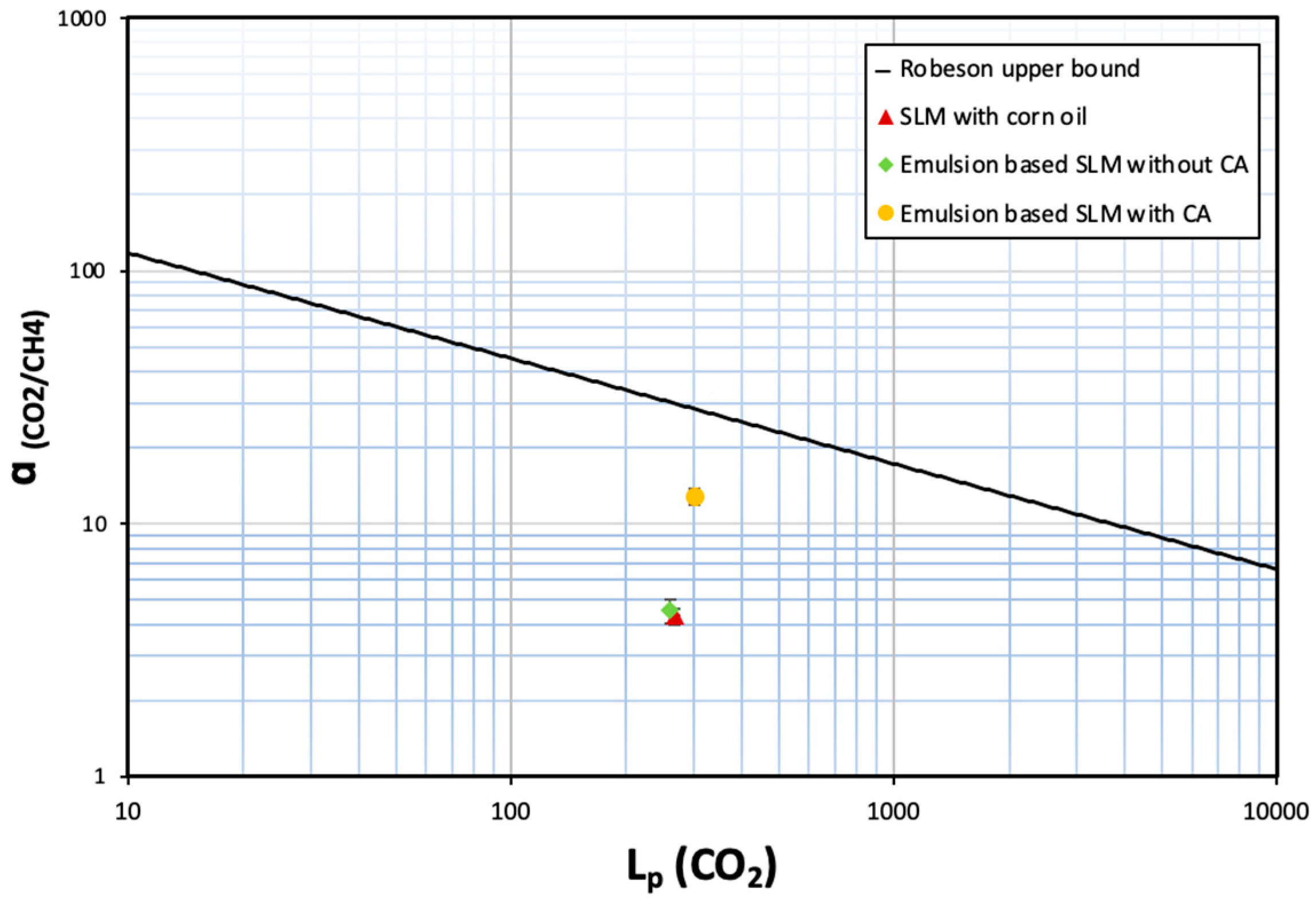Design of Enzyme Loaded W/O Emulsions by Direct Membrane Emulsification for CO2 Capture
Abstract
:1. Introduction
2. Materials and Methods
2.1. Materials
2.2. Schematic Representation of Experimental Workplan
2.3. Optimisation of the Two Phases to Produce Water-in-Oil Emulsions
2.3.1. Screening of Commercials Oils as Continuous Phase
2.3.2. Selection of Dispersed Phase
2.3.3. Characterisation of the Optimised Phases and the Membrane Used for Emulsification Studies
Interfacial Tension Studies
Contact Angle Studies
2.4. Formulation of Water-in-Oil Emulsions by Membrane Emulsification
2.5. Preparation of Supported Liquid Membranes
2.6. Gas Transport Studies
3. Results and Discussion
3.1. Formulation of Water-in-Oil Emulsions by Membrane Emulsification
3.1.1. Sorption Studies for Screening of Commercials Oils as Continuous Phase
3.1.2. Screening of Surfactants for Dispersed Phase
3.1.3. Optimisation of the Operating Conditions to Formulate Water-in-Oil Emulsions
3.2. Synthesis and Characterisation of Water-in-Oil Emulsions by Membrane Emulsification
3.2.1. Interfacial Tension Studies of the Two Phases
3.2.2. Contact Angle Measurements Associated with the Emulsification Process
3.3. Gas Transport Studies of CO2 and CH4 through the Synthesised Membranes
4. Conclusions
Author Contributions
Funding
Institutional Review Board Statement
Informed Consent Statement
Data Availability Statement
Acknowledgments
Conflicts of Interest
References
- Garba, M.D.; Usman, M.; Khan, S.; Shehzad, F.; Galadima, A.; Ehsan, M.F.; Ghanem, A.S.; Humayun, M. CO2 towards fuels: A review of catalytic conversion of carbon dioxide to hydrocarbons. J. Environ. Chem. Eng. 2021, 9, 104756. [Google Scholar] [CrossRef]
- Awe, O.W.; Zhao, Y.; Nzihou, A.; Minh, D.P.; Lyczko, N. A review of biogas utilisation, purification and upgrading technologies. Waste Biomass Valoriz. 2017, 8, 267–283. [Google Scholar] [CrossRef]
- Sun, Q.; Li, H.; Yan, J.; Liu, L.; Yu, Z.; Yu, X. Selection of appropriate biogas upgrading technology-a review of biogas cleaning, upgrading and utilisation. Renew. Sustain. Energy Rev. 2015, 51, 521–532. [Google Scholar] [CrossRef]
- Osman, A.I.; Hefny, M.; Abdel Maksoud, M.I.A.; Elgarahy, A.M.; Rooney, D.W. Recent advances in carbon capture storage and utilisation technologies: A review. Environ. Chem. Lett. 2021, 19, 797–849. [Google Scholar] [CrossRef]
- Embaye, A.S.; Martínez-Izquierdo, L.; Malankowska, M.; Téllez, C.; Coronas, J. Poly (ether-block-amide) copolymer membranes in CO2 separation applications. Energy Fuels 2021, 35, 17085–17102. [Google Scholar] [CrossRef]
- Gladis, A.; Lomholdt, N.F.; Fosbol, P.L.; Woodley, J.M.; von Solms, N. Pilot scale absorption experiments with carbonic anhydrase-enhanced MDEA—Benchmarking with 30 wt% MEA. Int. J. Greenh. Gas Control 2019, 82, 69–85. [Google Scholar] [CrossRef]
- Yamada, H. Amine-based capture of CO2 for utilization and storage. Polym. J. 2021, 53, 93–102. [Google Scholar] [CrossRef]
- Santoro, S.; Avci, A.H.; Politano, A.; Curcio, E. The advent of thermoplasmonic membrane distillation. Chem. Soc. Rev. 2022, 51, 6087–6125. [Google Scholar] [CrossRef]
- Quist-Jensen, C.A.; Ali, A.; Mondal, S.; Macedonio, F.; Drioli, E. A study of membrane distillation and crystallization for lithium recovery from high-concentrated aqueous solutions. J. Membr. Sci. 2016, 505, 167–173. [Google Scholar] [CrossRef]
- Russo, M.E.; Olivieri, G.; Marzocchella, A.; Salatino, P.; Caramuscio, P.; Cavaleiro, C. Post-combustion carbon capture mediated by carbonic anhydrase. Sep. Purif. Technol. 2013, 107, 331–339. [Google Scholar] [CrossRef]
- Talekar, S.; Jo, B.H.; Dordick, J.S.; Kim, J. Carbonic anhydrase for CO2 capture, conversion and utilization. Curr. Opin. Biotechnol. 2022, 74, 230–240. [Google Scholar] [CrossRef] [PubMed]
- Alvizo, O.; Nguyen, L.J.; Savile, C.K.; Bresson, J.A.; Lakhapatri, S.L.; Solis, E.O.; Fox, R.J.; Broering, J.M.; Benoit, M.R.; Zimmerman, S.A.; et al. Directed evolution of an ultrastable carbonic anhydrase for highly efficient carbon capture from flue gas. Proc. Natl. Acad. Sci. USA 2014, 111, 16436–16441. [Google Scholar] [CrossRef]
- Gebreyohannes, A.Y.; Upadhyaya, L.; Silva, L.P.; Falca, G.; Carvalho, P.J.; Nunes, S.P. Hollow fibers with encapsulated green amino acid-based ionic liquids for dehydration. ACS Sustain. Chem. Eng. 2020, 8, 17763–17771. [Google Scholar] [CrossRef]
- Ali, A.; Nymann, M.C.; Christensen, M.L.; Quist-Jensen, C.A. Industrial Wastewater Treatment by Nanofiltration—A Case Study on the Anodizing Industry. Membranes 2020, 10, 85. [Google Scholar] [CrossRef]
- Kumar, A.; Thakur, A.; Panesar, P.S. A review on emulsion liquid membrane (ELM) for the treatment of various industrial effluent streams. Rev. Environ. Sci. Biotechnol. 2019, 18, 153–182. [Google Scholar] [CrossRef]
- Li, N.N. Separating Hydrocarbons with Liquid Membranes. U.S. Patent 3,410,794, 12 November 1968. [Google Scholar]
- Li, N.N. Permeation through liquid surfactant membranes. AIChE J. 1971, 17, 459–463. [Google Scholar] [CrossRef]
- Chakraborty, M.; Bhattacharya, C.; Datta, S. Emulsion liquid membranes: Definitions and classification, theories, module design, applications, new directions, and perspectives. In Liquid Membranes; Kislik, V.S., Ed.; Elsevier: Amsterdam, The Netherlands, 2010; pp. 141–199. [Google Scholar]
- Syed, U.T.; Dias, A.M.; de Sousa, H.C.; Crespo, J.; Brazinha, C. Greening perfluorocarbon based nanoemulsions by direct membrane emulsification: Comparative studies with ultrasound emulsification on their formation and energy expenditure. J. Clean. Prod. 2022, 357, 131966. [Google Scholar] [CrossRef]
- Syed, U.T.; Dias, A.M.; Crespo, J.; Brazinha, C.; de Sousa, H.C. Studies on the formation and stability of perfluorodecalin nanoemulsions by ultrasound emulsification using novel surfactant systems. Colloids Surf. A Physicochem. Eng. Asp. 2021, 616, 126315. [Google Scholar] [CrossRef]
- Piacentini, E.; Mazzei, R.; Giorno, L. Comparison between Lipase Performance Distributed at the O/W Interface by Membrane Emulsification and by Mechanical Stirring. Membranes 2021, 11, 137. [Google Scholar] [CrossRef]
- Bazzarelli, F.; Piacentini, E.; Giorno, L. Biophenols-loaded solid lipid particles (SLPs) development by membrane emulsification. J. Membr. Sci. 2017, 541, 587–594. [Google Scholar] [CrossRef]
- Syed, U.T.; Leonardo, I.; Lahoz, R.; Gaspar, F.B.; Huertas, R.; Crespo, M.T.; Arruebo, M.; Crespo, J.G.; Sebastian, V.; Brazinha, C. Microengineered Membranes for Sustainable Production of Hydrophobic Deep Eutectic Solvent-Based Nanoemulsions by Membrane Emulsification for Enhanced Antimicrobial Activity. ACS Sustain. Chem. Eng. 2020, 8, 16526–16536. [Google Scholar] [CrossRef]
- Syed, U.T.; Leonardo, I.C.; Mendoza, G.; Gaspar, F.B.; Gámez, E.; Huertas, R.M.; Crespo, M.T.; Arruebo, M.; Crespo, J.G.; Sebastian, V.; et al. On the role of components of therapeutic hydrophobic deep eutectic solvent-based nanoemulsions sustainably produced by membrane-assisted nanoemulsification for enhanced antimicrobial activity. Sep. Purif. Technol. 2021, 285, 120319. [Google Scholar] [CrossRef]
- Inyang, V.; Lokhat, D. Parametric Study of the Extraction of Malic Acid Using Emulsion Liquid Membrane (ELM). Arab. J. Sci. Eng. 2022, 47, 6385–6394. [Google Scholar] [CrossRef]
- Inyang, V.; Lokhat, D. Propionic acid recovery from dilute aqueous solution by emulsion liquid membrane (ELM) technique: Optimization using response surface methodology (RSM) and artificial neural network (ANN) experimental design. Sep. Sci. Technol. 2022, 57, 284–300. [Google Scholar] [CrossRef]
- Fetimi, A.; Attef, D.Â.A.S.; Benguerba, Y.; Merouani, S.; Hamachi, M.; Kebiche-Senhadji, O.; Hamdaoui, O. Optimization and prediction of safranin-O cationic dye removal from aqueous solution by emulsion liquid membrane (ELM) using artificial neural network-particle swarm optimization (ANN-PSO) hybrid model and response surface methodology (RSM). J. Environ. Chem. Eng. 2021, 9, 105837. [Google Scholar] [CrossRef]
- Ahmad, A.L.; Buddin, M.S.; Ooi, B.S.; Kusumastuti, A. Utilization of environmentally benign emulsion liquid membrane (ELM) for cadmium extraction from aqueous solution. J. Water Process Eng. 2017, 15, 26–30. [Google Scholar] [CrossRef]
- Ma, H.; Kökkılıç, O.; Waters, K.E. The use of the emulsion liquid membrane technique to remove copper ions from aqueous systems using statistical experimental design. Miner. Eng. 2017, 107, 88–99. [Google Scholar] [CrossRef]
- Castro, A.M.D.; Ferreira, E.; Portugal, C.; Neves, L.A.; Crespo, J.G. Biocatalytic CO2 absorption and structural studies of carbonic anhydrase under industrially-relevant conditions. Int. J. Mol. Sci. 2020, 21, 2918. [Google Scholar] [CrossRef]
- Nabais, A.R.; Martins, A.P.; Alves, V.D.; Crespo, J.G.; Marrucho, I.M.; Tomé, L.C.; Neves, L.A. Poly (ionic liquid)-based engineered mixed matrix membranes for CO2/H2 separation. Sep. Purif. Technol. 2019, 222, 168–176. [Google Scholar] [CrossRef]
- Pérez, B.; Coletta, A.; Pedersen, J.N.; Petersen, S.V.; Periole, X.; Pedersen, J.S.; Sessions, R.B.; Guo, Z.; Perriman, A.; Schiøtt, B. Insight into the molecular mechanism behind PEG-mediated stabilization of biofluid lipases. Sci. Rep. 2018, 8, 12293. [Google Scholar] [CrossRef]
- Méndez Arias, J.; de Oliveira Moraes, A.; Modesto, L.F.A.; Castro, A.M.D.; Pereira, N., Jr. Addition of surfactants and non-hydrolytic proteins and their influence on enzymatic hydrolysis of pretreated sugarcane bagasse. Appl. Biochem. Biotechnol. 2017, 181, 593–603. [Google Scholar] [CrossRef] [PubMed]
- Tabibiazar, M.; Davaran, S.; Hashemi, M.; Homayonirad, A.; Rasoulzadeh, F.; Hamishehkar, H.; Mohammadifar, M.A. Design and fabrication of a food-grade albumin-stabilized nanoemulsion. Food Hydrocoll. 2015, 44, 220–228. [Google Scholar] [CrossRef]
- Piacentini, E.; Imbrogno, A.; Drioli, E.; Giorno, L. Membranes with tailored wettability properties for the generation of uniform emulsion droplets with high efficiency. J. Membr. Sci. 2014, 459, 96–103. [Google Scholar] [CrossRef]
- Fisher, L.R.; Mitchell, E.E.; Parker, N.S. Interfacial tensions of commercial vegetable oils with water. J. Food Sci. 1985, 50, 1201–1202. [Google Scholar] [CrossRef]
- Reddy, K.R.; Rai, R.K.; Green, S.J.; Chetri, J.K. Effect of pH on methane oxidation and community composition in landfill cover soil. J. Environ. Eng. 2020, 146, 4020037. [Google Scholar] [CrossRef]
- Robeson, L.M. The upper bound revisited. J. Membr. Sci. 2008, 320, 390–400. [Google Scholar] [CrossRef]










| Membrane Used | Membrane Specifications | Objective |
|---|---|---|
| UP 150 P Nadir® | Polyethersulfone (PES), 150 kDa (MWCO), 26 nm nominal pore size | Formulation of water-in-oil emulsions by membrane emulsification |
| Durapore® Membrane Filter | Hydrophobic Polyvinylidene fluoride (PVDF), 0.22 µm pore size | Support for the supported liquid membranes |
| Oils | Sorption Coefficient (cm3(STP)/(cm3.atm) |
|---|---|
| Corn Oil | 30.31 ± 0.23 |
| Olive Oil | 29.85 ± 0.05 |
| Sunflower Oil | 29.94 ± 0.05 |
| Membrane | Lp (CO2) (Barrer) | Lp (CH4) (Barrer) | Selectivity (α (CO2/CH4)) | |
|---|---|---|---|---|
| Support | Filler | |||
| Hydrophobic PVDF | Corn Oil | 267.40 ± 3.60 | 62.00 ± 3.70 | 4.31 ± 0.20 |
| Emulsion without carbonic anhydrase | 259.90 ± 3.30 | 57.30 ± 5.50 | 4.54 ± 0.40 | |
| Emulsion with carbonic anhydrase | 301.85 ± 7.45 | 23.55 ± 0.65 | 12.82 ± 0.10 | |
Publisher’s Note: MDPI stays neutral with regard to jurisdictional claims in published maps and institutional affiliations. |
© 2022 by the authors. Licensee MDPI, Basel, Switzerland. This article is an open access article distributed under the terms and conditions of the Creative Commons Attribution (CC BY) license (https://creativecommons.org/licenses/by/4.0/).
Share and Cite
Mondal, S.; Alke, B.; de Castro, A.M.; Ortiz-Albo, P.; Syed, U.T.; Crespo, J.G.; Brazinha, C. Design of Enzyme Loaded W/O Emulsions by Direct Membrane Emulsification for CO2 Capture. Membranes 2022, 12, 797. https://doi.org/10.3390/membranes12080797
Mondal S, Alke B, de Castro AM, Ortiz-Albo P, Syed UT, Crespo JG, Brazinha C. Design of Enzyme Loaded W/O Emulsions by Direct Membrane Emulsification for CO2 Capture. Membranes. 2022; 12(8):797. https://doi.org/10.3390/membranes12080797
Chicago/Turabian StyleMondal, Suchintan, Bhavna Alke, Aline Machado de Castro, Paloma Ortiz-Albo, Usman Taqui Syed, João G. Crespo, and Carla Brazinha. 2022. "Design of Enzyme Loaded W/O Emulsions by Direct Membrane Emulsification for CO2 Capture" Membranes 12, no. 8: 797. https://doi.org/10.3390/membranes12080797








